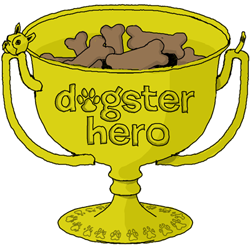
A Border Collie named Hunter located three girls barely breathing under four feet of rubble after Haiti’s 2010 earthquake. The previous year, Kura the Golden Retriever found a child lost in the woods of upstate New York.
Heroic? Just another day of fun and games for these two typical canine graduates of the Ojai, California-based National Disaster Search Dog Foundation, which has trained hundreds of life-saving dogs deployed to pinpoint the scents of human survivors in the immediate aftermaths of Hurricane Katrina, the Fukushima earthquake, the World Trade Center attacks, and dozens of other disasters.
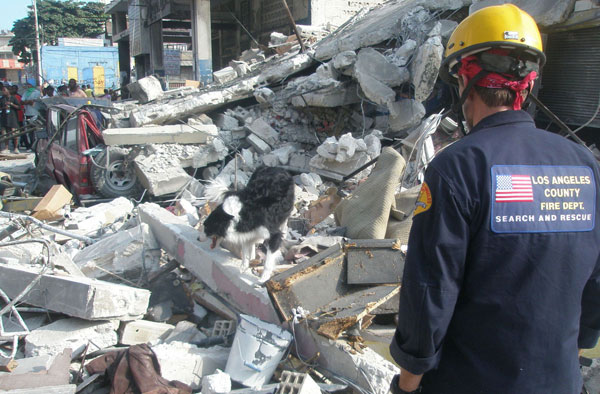
A nonprofit that survives entirely on private donations and grants, the National Disaster Search Dog Foundation — SDF, for short — is unique in that its students are themselves all rescues plucked from animal shelters around the United States, saved from uncertain fates by their eager personalities and irrepressible love of play. They’re trained to return the favor and now do the rescuing — of live human victims buried under fallen buildings or trapped in wrecked vehicles during those first few hours and days after disasters, when every second counts. They can also provide bittersweet reassurance that no living survivors remain and that everything possible has been done to find them.
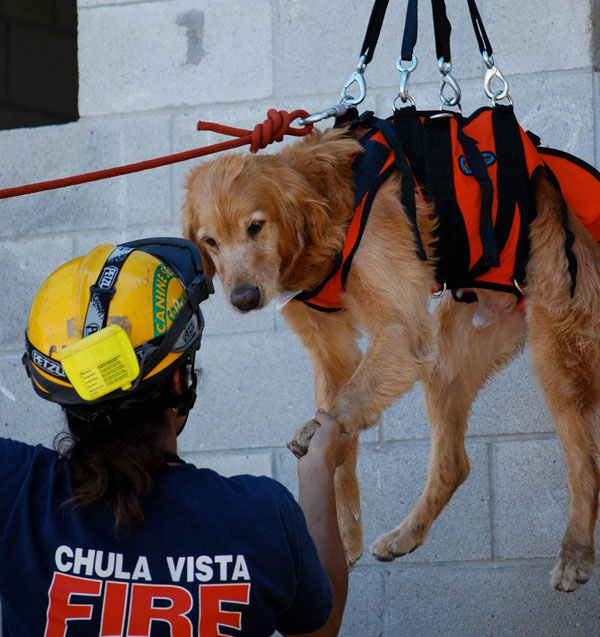
Dozens of SDF-trained teams now operate out of seven states, from which they are deployed to disasters wherever they occur.
They are adopted from shelters after medical checkups have shown them to be healthy and agile. “These are the kind of dogs that would otherwise get euthanized because no one can control them,” says SDF Community Relations Manager Celeste Matesevac. “They’re dogs who would be put on Ritalin if they were human. They have the highest energy, the highest toy drive. They’ll chew everything in the yard. They’re begging for a job, and they won’t calm down until they get a job. Once they’re taught to do this job, they’re the best you could ask for.”

Hunting breeds such as Labrador Retrievers, which are deft and strong enough to climb over any obstruction but still light enough to be easily rappelled out of helicopters, are the typical SDF “students.” While most other search dogs assisting first responders nationwide are trained only to detect cadavers, SDF’s training focuses on detecting the scent of living, breathing people.
“Working dogs don’t multitask. They’re trained to do one specific thing, in our case to find one specific scent: the scent of a live human,” Matesevac explains.
When they correctly identify the scent they’ve been trained to detect and thus located a live, trapped victim who might or might not be conscious, search dogs receive rewards — never food, in the case of SDF dogs, but cloth-and-rubber toys, which are easier for the handlers to carry and reinforce the dogs’ sense of play.
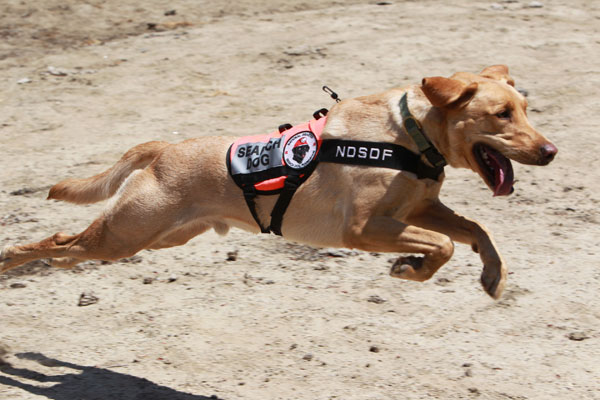
“The trapped victims our dogs find in disaster scenes obviously aren’t equipped with toys. So the handlers keep toys in their pockets and toss these to the dogs when the dogs make successful finds.” After playing with its reward for a moment, “a dog says: ‘OK! On to the next one!’ It’s a game to them. It keeps them excited.”
While we might like to imagine that search dogs know they are saving lives, we really aren’t sure: From the dogs’ point of view, even a real rescue could still be just a game. “They only know that if they do it right — if after detecting the correct scent they stand there barking long enough for the crew to reach that area — a toy will pop out,” Matesevac explains.
They learn to play this life-saving game during an intensive eight-month program. Dogs are not trained at the Ojai office, but rather at SDF’s new National Training Center, a state-of-the-art facility still under construction amidst 126 acres granted to SDF by a local ranching family in nearby Santa Paula. Just last week there, the Department of Defense began building SDF’s Disaster Training Zone, a hyper-realistic simulated urban setting which can be configured to look like the aftermath of an earthquake, hurricane or terror attack. The military has similar top-secret installations at bases around the country used to train Army Rangers, Navy SEALs and other human anti-terror squads. SDF’s dogs will be in some elite company.
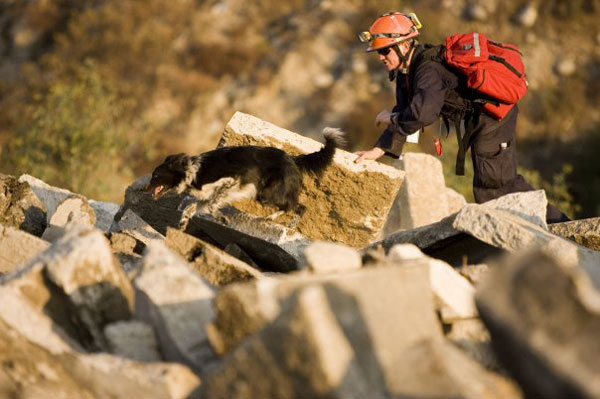
Eventually, perhaps in a year or two when construction is complete, SDF will open the training facility to docent-led public tours. Until then, the only way you can see the dogs training to become heroes is by becoming a donor or sponsor, which might snag you an invite to occasional on-site events for SDF supporters.
Until then, you can always drop by SDF’s business office right in the center of picturesque downtown Ojai, a laid-back and lovely southern California spa village and celebrity getaway, to offer gratitude, pick up literature, and greet the staff members’ own dogs in the pet-friendly headquarters.
SDF, it turns out, started by chance. When retired teacher Wilma Melville relocated from frantic Los Angeles to idyllic, sun-blessed, citrus-studded Ojai in hopes of pursuing her equestrian passions, she had no plans for launching a second career. But the inquisitive and bubbly personality of her adopted black Lab, Murphy, intrigued her.
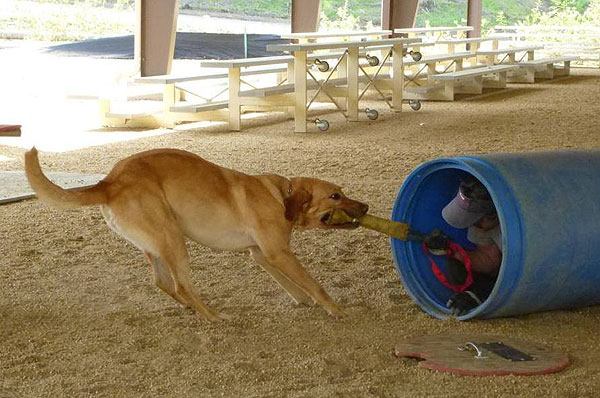
“The idea somehow occurred to Wilma: Murphy would make such a good search dog. I think I can train this dog to find the scent of a live person,” Matesevac says. Melville and Murphy trained together and earned Advanced Disaster Search Dog certification from FEMA in 1995 — and almost immediately found themselves deployed to the site of the Oklahoma City bombing, which happened right after they graduated.
Standing amidst the wreckage, imagining other catastrophes, and knowing that the lengthy, costly training process kept the number of certified search-dog teams tragically low (she and Murphy were then one of only 15 such teams nationwide), Melville configured a first-of-its-kind plan: a dog-training nonprofit that paired rescue animals with firefighters adept at first-responder skills.
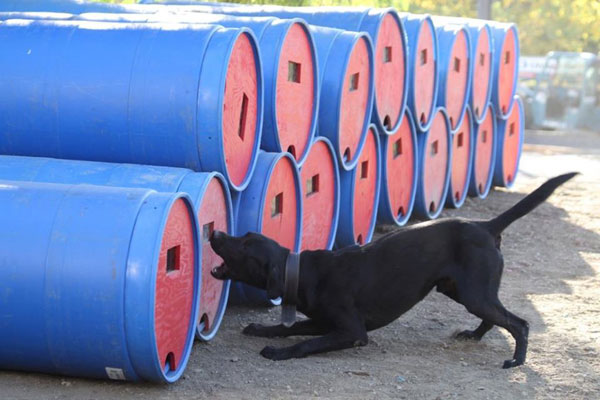
“She realized that there were so many dogs out there in shelters who would love this kind of job, and there was such a need for them,” Matesevac says. Within a few years, SDF’s graduates were “playing” at disasters around the world. Thirteen SDF-trained teams were deployed to Ground Zero within hours of the WTC terrorist attacks.
“Our name appeared on the news during live TV coverage,” Matesevac remembers, “and people started calling in from everywhere, wanting to donate, wanting to help. Schoolchildren were sending us doggie treats.”
Now, back at the National Training Center in Santa Paula, a few miles down a winding road from Ojai, military engineers continue building “Disaster City,” the ultimate dog playground — but with a very serious purpose. For next generation of Murphys, Hunters, and Kuras, it will all be part of a game. The game of saving lives.
Check out the National Disaster Search Dog Foundation website and Facebook page.
Read more on search-and-rescue dogs and working dogs:
- Enter the World of Cadaver Dogs, the Canines Who Sniff Out Missing People
- Meet Belle, a Dog Who Might Save Your Life in an Avalanche
- Penn Vet Working Dog Center: Where Detection Dogs Train
Read more about the bond between humans and dogs on Dogster:
- Leo the Puppy Mill Rescue Boxer Always Has His Mouth Full
- 3 Things My Senior Dog Has Taught Me About Aging Gracefully
- I Have a Baby AND a Pit Bull, and People Are Supportive
About the author: Kristan Lawsonlives in the San Francisco Bay Area and writes about travel, food, evolution and scavenging.
Do you know of a rescue hero — dog, human, or group — we should profile on Dogster? Write us at [email protected].




